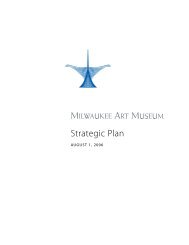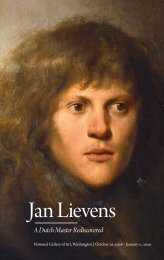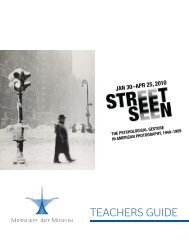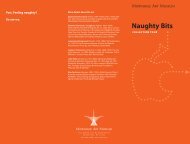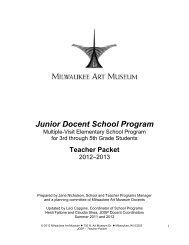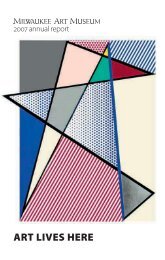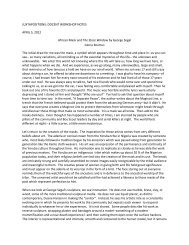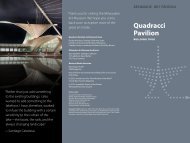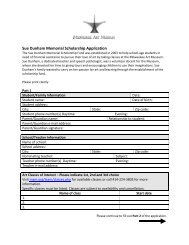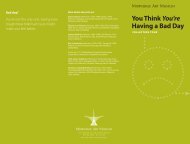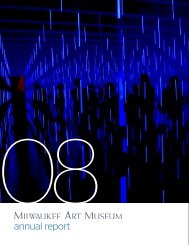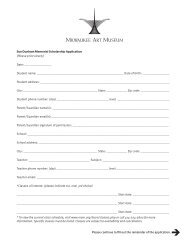Junior Docent School Program - Milwaukee Art Museum
Junior Docent School Program - Milwaukee Art Museum
Junior Docent School Program - Milwaukee Art Museum
Create successful ePaper yourself
Turn your PDF publications into a flip-book with our unique Google optimized e-Paper software.
22<br />
<br />
<br />
<br />
<br />
<br />
<br />
<br />
<br />
<br />
from the grumpiest grump<br />
to the fizziest fizz.<br />
And you and you and I<br />
know well<br />
each has a taste<br />
and each has a smell<br />
and each has a wonderful story to tell…<br />
Using felt pieces and a felt board, make a color wheel as you discuss color in a work of<br />
art. The primary colors are cut into three triangles; the secondary colors are cut into<br />
three circles.<br />
Make and show the students a picture out of felt pieces with warm colors using blue or<br />
purple for the background, brown for a table top, and three warm color shapes placed on<br />
the table – red, orange, yellow.<br />
Then make and show the children a picture out of felt pieces with cool colors using red<br />
or orange for the background, brown for the table top, and three cool color shapes<br />
placed on the table – blue, purple, green.<br />
Compare both pictures. “Which picture is more effective in showing perspective?” (The<br />
yellow, red, and orange shapes should visually stand out more effectively because warm<br />
colors advance while cool colors recede.) “How do you think color is used to create<br />
special effects?”<br />
Have the students stand in a large circle. Ask them to close their eyes and imagine that<br />
they are in a large, empty room. The room is all one color, very intense and bright red.<br />
“How do you feel standing in this room? How would you like being in this room all day?”<br />
Repeat with various colors.<br />
Invite students to look at works of art and identify red objects. “Does red look the same<br />
each time?”<br />
Using pairs of various one-color objects and various colored fadeless paper, choose a<br />
pair of objects and lay each of them on a different-colored background. “What<br />
combinations of color have the best contrast? (For example, orange object on an orange<br />
or blue background.) What combinations of color appear to vibrate?”<br />
Discuss how each color has certain feelings associated with it.<br />
Yellow = cheerful. Red = angry. Blue = sad.<br />
Invite the students to find the colors in a work of art and describe how the color<br />
makes them feel. “Are there other elements of art that support that feeling?”<br />
Kelly, Ellsworth, Red, Yellow, Blue II<br />
Use a felt board with felt pieces of triangles to discuss primary colors. Ask, “What<br />
happens when you mix red and blue colors together?” Add the corresponding circle<br />
to the point of the primary colors triangle. Continue with the remaining primary colors.<br />
Agam, Yaacov, Union II<br />
“What color do you see from this direction? What colors do you see from the other<br />
direction? Which are the warm colors? Which are the cool colors?” Using the felt board,<br />
place the colors in warm or cool color groups. Help the children remember the difference<br />
by offering the following explanations: red = fire, yellow = sun, orange = afterglow of fire,<br />
blue = ice, green = grass, purple = when you have been outside too long in winter.<br />
Hoffman, Hans, Dew and Dusk<br />
Use a felt board and create a warm color picture, then a cool color picture. Discuss with<br />
the students how an artist uses shape placement to create mood and balance action<br />
while thinking of color choices too. Compare and contrast the two pictures next to each<br />
other using identical shapes in each. Ask, “What color do you notice when you first look<br />
at the picture? Which color is in front and which color is in back?” Have the students look<br />
at a painting and discuss what happens when a warm color is placed next to a cool<br />
color.<br />
© 2011 <strong>Milwaukee</strong> <strong>Art</strong> <strong>Museum</strong> 700 N. <strong>Art</strong> <strong>Museum</strong> Dr. <strong>Milwaukee</strong>, WI 53202<br />
JDSP – <strong>Docent</strong> Packet



